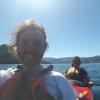news
Life of a graduate student in Ocean Science: a good 2016
Primary tabs
If you are reading this, it probably means you are considering a career in Engineering and Ocean Science. You’re on a great path! By sharing the highlights of my last year as a PhD candidate in Earth & Atmospheric Sciences researching ocean and climate dynamics, I hope to give you a glimpse into the life that could be awaiting you:
As of March 2015, when I successfully passed the PhD comprehensive exam, my course load has been reduced and I am concentrating most of my efforts in advancing my research. Since last January I published my first first-author paper in the international journal Climate Dynamics and I participated in several high-profile scientific conferences. I presented my research on Pacific decadal climate variability earlier this year at the 2016 Ocean Science Conference in New Orleans. After receiving feedback from other scientists attending the same conference, I improved my research and I presented my new and updated results few week ago at the CLIVAR conference in Qingdao, China. This long distance travel was possible because I was awarded a travel grant by the CLIVAR organization, that allowed me to attend both the CLIVAR Early Career Scientists Symposium and the CLIVAR Open Science Conference. This conference was very useful since I expanded my professional network, meeting potential future collaborators and employers, learned about the major research topics in climate Science, and I got to see the cities of Beijing and Qingdao, as well as the Great Wall.
In June I broadened the scope of my research by involving myself in a project aimed at studying the impact of climate change on Peruvian tropical glaciers. As part of the project, I travelled to Lima, Peru, to attended a workshop and to teach a five-day course on Climate Data Analysis to climate scientists and graduate students. Moreover, after the workshop in Lima, a few of us went on an incredible three-day field trip to the Andean glacier of Artesonraju, hiking up to an altitude of about 18,000 feet! Our field trip was broadcast by the Peruvian TV news station and can be seen here: https://www.youtube.com/watch?v=UUVkQ5zARMk
Peru and China were not the only long-distance trips this summer. In fact, although I have been mostly focused on advancing my research, this August I had the honor of being selected for the 2016 Advanced Climate Dynamics Courses, which is high-profile international summer school for advanced PhD candidates and early career scientists. During this two-week intensive course, which this year took place in the marvelous nature of Labrador Island, Canada, I significantly deepened my understanding of high-latitude climate variability and I made a lot of new friends and potential collaborators. Besides the science, I enjoyed some extraordinary outdoor activity, such as hiking the Earth’s mantle in the unique Tablelands, and discovering a wild minke whale swimming just few meters from me while kayaking in an almost virgin Fjord.
Currently, I am writing my second first-author paper that I hope to submit to Nature Geoscience journal by the end of November. In the meanwhile, I will be attending a workshop in Madison next week, an interdisciplinary climate conference in Seattle at the end of October, and will be preparing for the fall meeting of the American Geoscience Union which will be held in San Francisco in December.
I hope this gives you an idea of what a year in the life of a PhD candidate in Ocean Science can be like; busy, engaging, and rewarding!
Giovanni Liguori
Giovanni Liguori is a 4th years PhD candidate at the School of Earth and Atmospheric Sciences here at Georgia Tech. His scientific interest is oceanography and climate dynamics from interannual to decadal timescales. His current project focuses on the mechanisms responsible for theobserved Pacific decadal variability, which impact long-term transitions in marine ecosystems and influence the statistics of weather including ocean and atmosphere extremes such as strong droughts, hurricanes and marine heatwaves. Specifically, combining observations and model outputs, He is studying how tropical and extra-tropical Pacific climate modes interact to produce decadal variability.
Website: www.oceanography.eas.gatech.edu/gianni
Status
- Workflow status: Published
- Created by: Emanuele Di Lorenzo
- Created: 10/15/2016
- Modified By: Emanuele Di Lorenzo
- Modified: 10/25/2016
Categories




